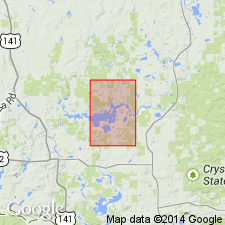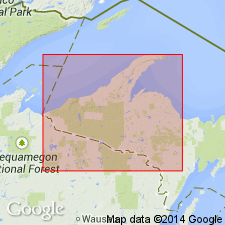
- Usage in publication:
-
- Randville dolomite*
- Modifications:
-
- Overview
- AAPG geologic province:
-
- Lake Superior region
Summary:
Is oldest Middle Precambrian formation mapped in Kiernan quad, eastern Iron Co, MI (Lake Superior region). Is mainly buff-colored to pale pink, fine- to medium-grained dolomite commonly with clastic quartz; weathers to typical yellow brown. Thin layers and minor members comprised of fine- to medium-grained feldspathic and dolomitic quartzite; pinkish medium- to coarse-grained arkose; gray fine-grained quartz-sericite slate and schist and chlorite-sericite schist; slaty fine- to medium-grained graywacke; and white to reddish brecciated cherty and quartzose probable silicified dolomite. Thickness about 1,800 ft. Lower and upper contacts unconformable. Overlies Lower Precambrian Margeson Creek gneiss (new) or unnamed magnetic green schist that is correlated with Dickinson group (first used). Overlain locally by Goodrich quartzite and elsewhere by Hemlock formation. Quartz-sericite schist and slate exposed along the Fence River were placed in the Sturgeon quartzite by Clements and Smyth (1899), but are assigned to the base of the Randville in this report. Sericite slate west of center of sec 32, T44N, R31W, was correlated with "Mansfield slate" by Clements and Smyth (1899), but is herein considered either an upper member of the dolomite or a distinct unit above the dolomite.
Source: GNU records (USGS DDS-6; Reston GNULEX).

- Usage in publication:
-
- Randville dolomite*
- Modifications:
-
- Revised
- Areal extent
- AAPG geologic province:
-
- Lake Superior region
Summary:
Is uppermost unit of revised Chocolay group (new) of Animikie series in northwest MI in the Lake Superior region. Is only formation of Chocolay group in area, present only in southern Iron Co. Is partially correlative with Saunders formation. Stratigraphic sequence chart. Is middle Precambrian in age.
Source: GNU records (USGS DDS-6; Reston GNULEX).

- Usage in publication:
-
- Randville Dolomite*
- Modifications:
-
- Overview
- AAPG geologic province:
-
- Lake Superior region
Summary:
Pg. 2845 (fig. 2, stratigraphic chart compiled from Leith and others, 1935; James, 1958; Gair and Thaden, 1968). Randville Dolomite of Chocolay Group of Marquette Range Supergroup (new; replaces †Animikie series of James, 1958, south of Lake Superior, in Michigan and Wisconsin). Present in Menominee Range, northwestern Michigan. Uconformably underlies Felch Formation of Menominee Group; overlies Sturgeon Quartzite of Chocolay Group. Age is middle Precambrian.
Source: Publication.
For more information, please contact Nancy Stamm, Geologic Names Committee Secretary.
Asterisk (*) indicates published by U.S. Geological Survey authors.
"No current usage" (†) implies that a name has been abandoned or has fallen into disuse. Former usage and, if known, replacement name given in parentheses ( ).
Slash (/) indicates name conflicts with nomenclatural guidelines (CSN, 1933; ACSN, 1961, 1970; NACSN, 1983, 2005, 2021). May be explained within brackets ([ ]).

